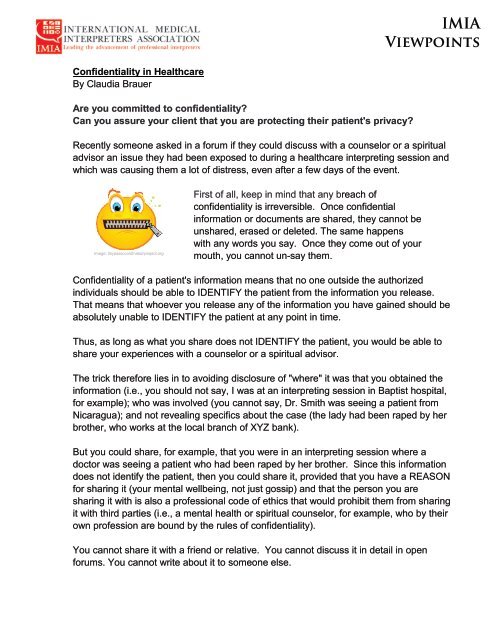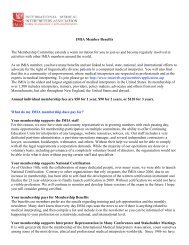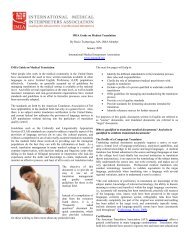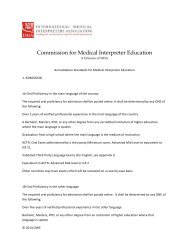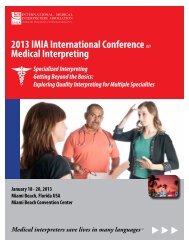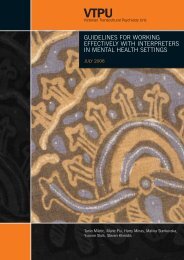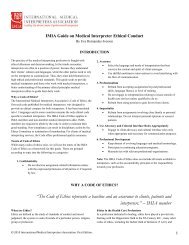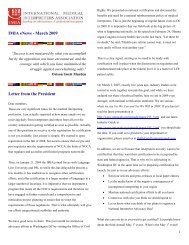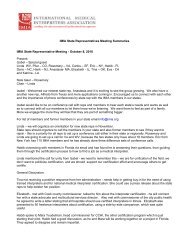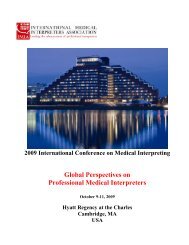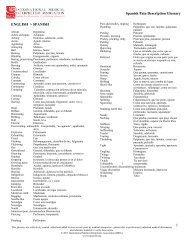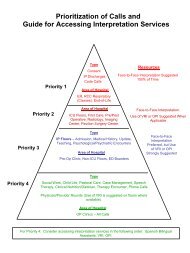Confidentiality in Healthcare
Confidentiality in Healthcare
Confidentiality in Healthcare
Create successful ePaper yourself
Turn your PDF publications into a flip-book with our unique Google optimized e-Paper software.
IMIAViewpo<strong>in</strong>ts<strong>Confidentiality</strong> <strong>in</strong> <strong>Healthcare</strong>By Claudia BrauerAre you committed to confidentiality?Can you assure your client that you are protect<strong>in</strong>g their patient's privacy?Recently someone asked <strong>in</strong> a forum if they could discuss with a counselor or a spiritualadvisor an issue they had been exposed to dur<strong>in</strong>g a healthcare <strong>in</strong>terpret<strong>in</strong>g session andwhich was caus<strong>in</strong>g them a lot of distress, even after a few days of the event.Image: ilbypasscoord<strong>in</strong>ationproject.orgFirst of all, keep <strong>in</strong> m<strong>in</strong>d that any breach ofconfidentiality is irreversible. Once confidential<strong>in</strong>formation or documents are shared, they cannot beunshared, erased or deleted. The same happenswith any words you say. Once they come out of yourmouth, you cannot un-say them.<strong>Confidentiality</strong> of a patient's <strong>in</strong>formation means that no one outside the authorized<strong>in</strong>dividuals should be able to IDENTIFY the patient from the <strong>in</strong>formation you release.That means that whoever you release any of the <strong>in</strong>formation you have ga<strong>in</strong>ed should beabsolutely unable to IDENTIFY the patient at any po<strong>in</strong>t <strong>in</strong> time.Thus, as long as what you share does not IDENTIFY the patient, you would be able toshare your experiences with a counselor or a spiritual advisor.The trick therefore lies <strong>in</strong> to avoid<strong>in</strong>g disclosure of "where" it was that you obta<strong>in</strong>ed the<strong>in</strong>formation (i.e., you should not say, I was at an <strong>in</strong>terpret<strong>in</strong>g session <strong>in</strong> Baptist hospital,for example); who was <strong>in</strong>volved (you cannot say, Dr. Smith was see<strong>in</strong>g a patient fromNicaragua); and not reveal<strong>in</strong>g specifics about the case (the lady had been raped by herbrother, who works at the local branch of XYZ bank).But you could share, for example, that you were <strong>in</strong> an <strong>in</strong>terpret<strong>in</strong>g session where adoctor was see<strong>in</strong>g a patient who had been raped by her brother. S<strong>in</strong>ce this <strong>in</strong>formationdoes not identify the patient, then you could share it, provided that you have a REASONfor shar<strong>in</strong>g it (your mental wellbe<strong>in</strong>g, not just gossip) and that the person you areshar<strong>in</strong>g it with is also a professional code of ethics that would prohibit them from shar<strong>in</strong>git with third parties (i.e., a mental health or spiritual counselor, for example, who by theirown profession are bound by the rules of confidentiality).You cannot share it with a friend or relative. You cannot discuss it <strong>in</strong> detail <strong>in</strong> openforums. You cannot write about it to someone else.
IMIAViewpo<strong>in</strong>ts<strong>Confidentiality</strong> <strong>in</strong> <strong>Healthcare</strong> – Pg. 2By Claudia BrauerIn the United States, HIPAA (1) regulations clearly state the "IDENTIFIERS" of what iscalled "PROTECTED HEALTH INFORMATION", which are those identifiers that youcannot share with others. They <strong>in</strong>clude name, address, telephone, fax, email, socialsecurity number, medical record number, account number, health plan number, driverslicense number, vehicle identification, device identifiers and serial numbers, names ofrelatives, URL, IP address, biometric identifiers, photos, date of birth, admission date,discharge date, date of death, exact age, and <strong>in</strong> general, any other UNIQUEIDENTIFYING NUMBER, CHARACTERISTIC or CODE.Ma<strong>in</strong>ta<strong>in</strong><strong>in</strong>g the privacy and confidentiality of a client’s <strong>in</strong>formation, obta<strong>in</strong>ed verbally, <strong>in</strong>writ<strong>in</strong>g, or any other way, is very serious bus<strong>in</strong>ess. Pursuant to ISO-17799 (2) :“<strong>Confidentiality</strong> (implies) ensur<strong>in</strong>g that <strong>in</strong>formation is accessible only to those authorizedto have access.” Additionally, privacy means, “not be<strong>in</strong>g available for public view<strong>in</strong>g orknowledge,” and private <strong>in</strong>formation should always be treated as confidential<strong>in</strong>formation. F<strong>in</strong>ally, Protected Health Information (PHI) is “any <strong>in</strong>formation about healthstatus, provision of health care, or payment for health care that can be l<strong>in</strong>ked to aspecific <strong>in</strong>dividual.” (HIPAA def<strong>in</strong>ition)Image: nycpartnersforfamilies.orgSo, <strong>in</strong> short, you can only share your thoughts or <strong>in</strong>formationoutside the encounter if and when:(a) it is with the treatment team authorized to know the<strong>in</strong>formation;(b) it is with a professional bound himself/herself byconfidentiality;(c) you do it because you "need" to, not because you "want"to (gossip); and(d) you do not reveal any specific <strong>in</strong>formation that would allowthe <strong>in</strong>dividual to be identified.Let’s suppose you have a secret from your youth and for some reason, you musttranslate some related documents <strong>in</strong>to French. You trust the translator. However, yoursecret gets posted on Facebook. How would you feel? The same feel<strong>in</strong>g and the samereaction could be that of your client if some confidential <strong>in</strong>formation they provided dur<strong>in</strong>gan <strong>in</strong>terpret<strong>in</strong>g encounter suddenly became known to others. Not nice, right?In my op<strong>in</strong>ion, one of the most important standards of practice and ethical commitments<strong>in</strong> translation and <strong>in</strong>terpret<strong>in</strong>g is trust and confidentiality. In the ideal world, everytranslator and <strong>in</strong>terpreters would ALWAYS act as if they had signed a detailedconfidentiality agreement for every s<strong>in</strong>gle assignment they undertake, stat<strong>in</strong>g that theywill abide by the strictest guidel<strong>in</strong>es and pr<strong>in</strong>ciples of ethics, confidentiality, privacy andphysical security.
IMIAViewpo<strong>in</strong>ts<strong>Confidentiality</strong> <strong>in</strong> <strong>Healthcare</strong> – Pg. 3By Claudia BrauerAs a translator or <strong>in</strong>terpreter, we handle huge numbers of documents and largeamounts of <strong>in</strong>formation, much of which conta<strong>in</strong>s sensitive content, private and personaldata, and confidential <strong>in</strong>formation. There is always great risk that such <strong>in</strong>formation mayleak out, even un<strong>in</strong>tentionally, unless we take proactive steps to prevent that fromhappen<strong>in</strong>g. It is not enough that the leak<strong>in</strong>g would have occurred due to an "error" onour part. There are very few <strong>in</strong>stances where you can allege real "errors" <strong>in</strong> thedisclosure of private or confidential <strong>in</strong>formation. Most of them are preventable and youare required to take very specific steps to ensure you are prevent<strong>in</strong>g any un<strong>in</strong>tentional(and <strong>in</strong>tentional) leaks of <strong>in</strong>formation.Confidential <strong>in</strong>formation does not necessarily have to be recorded <strong>in</strong> material format. Itmay also be <strong>in</strong>formation acquired verbally (<strong>in</strong> person, over the phone or byvideoconference), or knowledge ga<strong>in</strong>ed <strong>in</strong>advertently (someth<strong>in</strong>g you see dur<strong>in</strong>g anencounter, for example).To ensure privacy and confidentiality of the <strong>in</strong>formation that is provided to us or whichwe become aware of verbally means that you must have <strong>in</strong> place rules and protectionsto preserve the privacy of the persons as well as the confidentiality of their <strong>in</strong>formation,which, once we known by us, is considered to be under our care. It also means thatsuch <strong>in</strong>formation and documents must be kept <strong>in</strong> strict confidence and that access mustbe granted or provided solely to those specifically authorized by the owner or by law.-------------------------(1) HIPAA (http://www.hhs.gov/ocr/privacy/) - "The HIPAA Privacy Rule provides federal protections for personal health <strong>in</strong>formationheld by covered entities and gives patients an array of rights with respect to that <strong>in</strong>formation. At the same time, the Privacy Rule isbalanced so that it permits the disclosure of personal health <strong>in</strong>formation needed for patient care and other important purposes. TheSecurity Rule specifies a series of adm<strong>in</strong>istrative, physical, and technical safeguards for covered entities to use to assure theconfidentiality, <strong>in</strong>tegrity, and availability of electronic protected health <strong>in</strong>formation."(2) ISO-17799 (http://17799.macassistant.com/def.htm). ISO17799 is a detailed security standard organized <strong>in</strong>to ten major sections,each cover<strong>in</strong>g a different topic or area. These <strong>in</strong>clude, amongst others, physical, personal and environmental security measures toprevent unauthorized access, damage, and <strong>in</strong>terference to <strong>in</strong>formation; and to prevent compromise, theft or disclosure of<strong>in</strong>formation; to avoid breaches of any crim<strong>in</strong>al or civil law, statutory, regulatory or contractual obligations and of any securityrequirements; to reduce risks of human error, theft, fraud or misuse of <strong>in</strong>formation; to ensure that users are aware of <strong>in</strong>formationsecurity threats and concerns, and are equipped to support the security policies <strong>in</strong> the course of their normal work.


